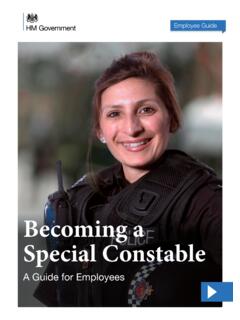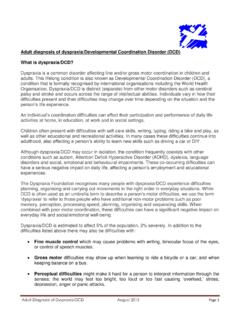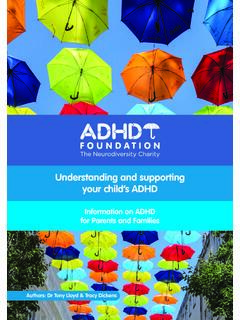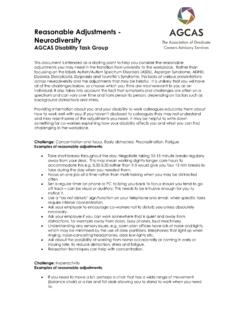Transcription of Dyslexia, Dyspraxia, Dyscalculia and Dysgraphia Line ...
1 1 Dyslexia, dyspraxia , Dyscalculia and Dysgraphia Line Managers Toolkit 2 Contents Foreword 4 Message from the CSDDN network and how to use this toolkit. 5 What are dyslexia, dyspraxia , Dyscalculia and Dysgraphia 7 Dyslexia 7 dyspraxia 7 Dyscalculia 7 Dysgraphia 7 Understand the strengths and challenges 9 How you can help us 10 Things to remember 10 Support workplace adjustments 11 Examples of workplace adjustments 11 Examples of technology adjustments 12 Requesting workplace adjustments 12 Background noise and the work environment 15 Following instructions 17 Practical tasks 18 Reading 20 Challenges of job applications 21 Social situations, meetings and conferences 24 Staying on task 26 Wellbeing at work 28 Working visually 30 Working in hazardous conditions 32 Writing 33 Annex A Jargon buster 36 Working memory 36 Short term memory 36 Processing speed 36 Auditory or visual processing 36 Sensory overload 36 3 Visual difficulties 37 The Rose Review 37 UK DCD descriptor (2018) DIDA (2018)
2 38 Annex B workplace adjustment passports 39 The purpose of the workplace adjustment passport 39 The workplace adjustment passport application process 40 Individual responsibilities 40 Line manager responsibilities 41 Further information about workplace adjustment passports 42 Example of a completed workplace adjustment passport 43 4 Foreword I am delighted to introduce this Dyslexia, dyspraxia , Dyscalculia and Dysgraphia Line Managers Toolkit. It represents a fantastic step forward in improving the Civil Service wide understanding of these conditions and how line managers can support staff to be their best. Dyslexia, dyspraxia , Dyscalculia and Dysgraphia are conditions which affect a significant portion of the Civil Service and as such making progress in this area will make a great contribution to our ambition for a diverse, inclusive and brilliant Civil Service. I know first-hand that these conditions can present challenges and barriers to success but also bring with them different strengths.
3 With the right support, the challenges can be overcome, and we can harness the strengths these conditions bring. I sincerely hope this document aids both line managers and staff with these conditions to have meaningful conversations which lead to a better workplace for all. Sir Chris Wormald KCB Permanent Secretary Department of Health and Social Care Civil Service Dyslexia and dyspraxia Network Champion 5 Message from the CSDDN network and how to use this toolkit. This Toolkit is designed to support line managers and those with dyslexia, dyspraxia , Dyscalculia and Dysgraphia to have quality and informed conversations. Through this the civil service can be a supportive and inclusive environment which harnesses the unique strengths people with neurodiverse conditions can bring. It is written by and from the perspective of staff with these conditions. It is deliberately comprehensive but is split into two easy to use parts, with some annexes. The first part is aimed more at line managers to help them understand what these conditions are and how they can help.
4 The second part goes into more detail about specific work settings and helps staff with these conditions to articulate to their management what challenges they face and how they can help. It also includes practical advice about reasonable adjustments and associated workplace passports. It has been developed by the Civil Service Dyslexia and dyspraxia Network, in concert with Civil Service HR, which represents civil servants with those conditions as part of the broader Civil Service Disability Network. The CSDDN works to celebrate neurodiversity, strengthen the network, support staff and increase awareness of these conditions. We are proud to have published this toolkit and we are always looking for ideas as to how we can improve our advice and approach. If you have any feedback on this document or would like to join the network please email I would like to thank all members of the network who have worked to pull this together but in particular I would like to thank Heather Wilson and Lou Horton for their efforts.
5 Nick Hamer MBE Chair of the Civil Service Dyslexia and dyspraxia Network 6 PART 1 3 THINGS YOU CAN DO 1)Understand the strengths and challenges of those with these conditions. 2)Think through what you can do to help and have good conversations with your staff. 3)Support staff through workplace adjustments. 7 What are dyslexia, dyspraxia , Dyscalculia and Dysgraphia These diagnoses can be classed, in legislation, as disabilities due to the impact they have. We may have more than one diagnosis, alongside other conditions, but is also possible many of us have these conditions but have not been medically diagnosed. It s possible that even with a diagnosis, we may still not have a full explanation or understanding of the strengths and challenges of our condition/s. While diagnoses across dyslexia, dyspraxia , Dyscalculia and Dysgraphia have a lot in common, there are differences across these conditions. Full definitions are included in Annex A but in summary: Dyslexia Dyslexia impacts literacy and certain abilities used for learning including reading and writing and remembering and processing information.
6 dyspraxia dyspraxia , also known as developmental coordination disorder (DCD). It affects physical coordination and balance. Dyscalculia Dyscalculia is to do with numbers. It makes it difficult to understand and work with numbers, perform calculations and remember facts in mathematics. Dysgraphia Dysgraphia is to do with handwriting. It affects the physical ability to write, and also the coherence of what is written. 8 Emotions following a diagnosis Alongside the diagnosed symptoms of these conditions there will also be an emotional component. While diagnosis during education is improving many of us are diagnosed later in life, well into their careers. Below is the lived experience of these emotions from a member of the CSDDN which are not uncommon fears. Last week I was diagnosed with dyslexia. I ve long suspected this but it was a real shock when I was told. I was told I have lots of amazing skills but I didn t take in what was said. I feel like I am on an emotional rollercoaster.
7 I now have an explanation about why I failed all those exams, why I feel like I am failing at work and why I feel like I haven t achieved my full potential. My diagnosis means I am disabled. I don t feel disabled. I m told it is a disability because of the impact it has caused by the way society is designed. Am I disabled enough to ask for adjustments? Surely there are others more deserving? I m not sure how to ask for adjustments Not sure what to ask for. Not sure to I will be taken seriously I don t know what I am good at. No one has really told me before. It feels really personal. I don t feel able to share. Sometimes I m absolutely ok with it. Other times I really struggle to accept the diagnosis. All those messages of not good enough feel so real. I don t feel able to share my diagnosis with my colleagues. I fear failure and being judged by others. I worry my career will be impacted. I have a deep, deep feeling of shame. 9 Understand the strengths and challenges Each individual has a different experience, with unique skills and challenges.
8 A solution that works for one of us may not be the same solution that helps someone else. There are some things that we are really good at, and others things that other people are better at. This can be a helpful way to explain strengths and weaknesses as it can help keep the conversation positive. These are some examples of strengths we may have, and some things we can find challenging. They are not exhaustive and do not necessarily apply to everyone. We can be really good at: Sometimes other people are better at: Coming up with ideas Solving problems as we can see the situation from another perspective Making unexpected connections Spotting patterns and analytical skills Storytelling Thinking visually or in 3D Diversity of thought Remembering something connected which happened a long time ago Finding the 3 relevant points in two pages of text Imagining what the future looks like Simplifying processes Communicating verbally or presenting And so much more!
9 Consistently being accurate with attention to detail Writing in a 'house style' Reading aloud Writing things by hand Knowing how to structure a report or document Following grammar rules and spelling Remembering instructions Following long processes or instructions with multiple steps Remembering things - for example where a room is, the meaning of a word, or where they put something Being tidy Staying on task Knowing instinctively how to use equipment Not bumping into things they are close to 10 Not being easily distracted by sounds Passing tests and assessments Rote learning (remembering things by repeating them over and over again, like your times tables in maths) How you can help us There are lots of ways you can help make things easier: Find information on your department s or agencies intranet or speak to your HR department and support us through those processes to get the support/ adjustments we need. Keep an open mind Be patient Find out what we are good at, and don t judge us for what we are not so good at Use manager discretion fairly, taking into consideration our conditions.
10 Don t be unnecessarily punitive where you don t need to be. Have faith in our ability and strengths Allocate us tasks which suit our strengths Don t micromanage the way we do things, focus on the results Recognise that some of us might have other neurodiverse conditions (for example autism, ADHD, bipolar disorder, Tourette's syndrome) If force performance measures are required, then take into consideration our conditions and adjust accordingly. Our conditions may be the cause of our poor performance and adjustments may be a better course of action. Things to remember It can be challenging, but try to remember: Everyone is unique - that includes our skill sets One size does not fit all - what works for one of us might not work for someone else 11 We will bring something different to the team We sometimes know what works best for us, so ask us if we need help - but we may not always have a solution or fully understand our challenges. Learning about our challenges is ongoing.



